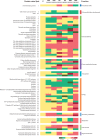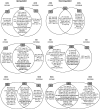Poplar woody taproot under bending stress: the asymmetric response of the convex and concave sides
- PMID: 27558889
- PMCID: PMC5055640
- DOI: 10.1093/aob/mcw159
Poplar woody taproot under bending stress: the asymmetric response of the convex and concave sides
Abstract
Background and Aims Progress has been made in understanding the physiological and molecular basis of root response to mechanical stress, especially in the model plant Arabidopsis thaliana, in which bending causes the initiation of lateral root primordia toward the convex side of the bent root. In the case of woody roots, it has been reported that mechanical stress induces an asymmetric distribution of lateral roots and reaction wood formation, but the mechanisms underlying these responses are largely unknown. In the present work, the hypothesis was tested that bending could determine an asymmetric response in the two sides of the main root axis as cells are stretched on the convex side and compressed on the concave side. Methods Woody taproots of 20 seedlings were bent to an angle of 90° using a steel net. Changes in the anatomy, lignin and phytohormone content and proteome expression in the two sides of the bent root were analysed; anatomical changes, including dissimilarities and similarities to those found in poplar bent woody stem, were also considered. Key Results Compression forces at the concave side of poplar root induced the formation of reaction wood which presented a high lignin content and was associated with the induction of cambium cell activity. Auxin seemed to be the main hormone triggering lignin deposition and cell wall strengthening in the concave sides. Abscisic acid appeared to function in the water stress response induced by xylem structures and/or osmotic alterations in the compression sides, whereas gibberellins may control cell elongation and gravitropisms. Conclusions Poplar root reaction wood showed characteristics different from those produced in bent stem. Besides providing biomechanical functions, a bent root ensures water uptake and transport in the deforming condition induced by tension and compression forces by two different strategies: an increase in xylem thickness in the compressed side, and lateral root formation in the tension side.
Keywords: Mechanical stress; phytohormones; proteomics; reaction wood; root anatomy.
© The Author 2016. Published by Oxford University Press on behalf of the Annals of Botany Company. All rights reserved. For Permissions, please email: journals.permissions@oup.com.
Figures








Similar articles
-
Reaction Wood Anatomical Traits and Hormonal Profiles in Poplar Bent Stem and Root.Front Plant Sci. 2020 Dec 7;11:590985. doi: 10.3389/fpls.2020.590985. eCollection 2020. Front Plant Sci. 2020. PMID: 33363556 Free PMC article.
-
The proteome of Populus nigra woody root: response to bending.Ann Bot. 2012 Jul;110(2):415-32. doi: 10.1093/aob/mcs040. Epub 2012 Mar 20. Ann Bot. 2012. PMID: 22437664 Free PMC article.
-
MicroRNAs expression patterns in the response of poplar woody root to bending stress.Planta. 2015 Jul;242(1):339-51. doi: 10.1007/s00425-015-2311-7. Epub 2015 May 12. Planta. 2015. PMID: 25963516
-
Tension wood as a model for functional genomics of wood formation.New Phytol. 2004 Oct;164(1):63-72. doi: 10.1111/j.1469-8137.2004.01176.x. New Phytol. 2004. PMID: 33873474 Review.
-
Zoom-in to molecular mechanisms underlying root growth and function under heterogeneous soil environment and abiotic stresses.Planta. 2023 Oct 29;258(6):108. doi: 10.1007/s00425-023-04262-5. Planta. 2023. PMID: 37898971 Review.
Cited by
-
The Pellicle-Another Strategy of the Root Apex Protection against Mechanical Stress?Int J Mol Sci. 2021 Nov 24;22(23):12711. doi: 10.3390/ijms222312711. Int J Mol Sci. 2021. PMID: 34884528 Free PMC article.
-
Shoring up the base: the development and regulation of cortical sclerenchyma in grass nodal roots.bioRxiv [Preprint]. 2024 Jan 29:2024.01.25.577257. doi: 10.1101/2024.01.25.577257. bioRxiv. 2024. Update in: Plant Physiol. 2025 Jun 03:kiaf215. doi: 10.1093/plphys/kiaf215. PMID: 38352548 Free PMC article. Updated. Preprint.
-
Formation of Annual Ring Eccentricity in Coarse Roots within the Root Cage of Pinus ponderosa Growing on Slopes.Plants (Basel). 2020 Feb 2;9(2):181. doi: 10.3390/plants9020181. Plants (Basel). 2020. PMID: 32024307 Free PMC article.
-
The Course of Mechanical Stress: Types, Perception, and Plant Response.Biology (Basel). 2023 Jan 30;12(2):217. doi: 10.3390/biology12020217. Biology (Basel). 2023. PMID: 36829495 Free PMC article. Review.
-
Network-Based Analysis to Identify Hub Genes Involved in Spatial Root Response to Mechanical Constrains.Cells. 2022 Oct 4;11(19):3121. doi: 10.3390/cells11193121. Cells. 2022. PMID: 36231084 Free PMC article.
References
-
- Abedini R, Clair B, Pourtahmasi K, Laurans F, Arnould O. 2015. Cell wall thickening in developing tension wood of artificially bent poplar trees. IAWA Journal 36: 44–57.
-
- Abeles FB, Morgan PW, Saltveit ME., Jr. 1992. Ethylene in plant biology, 2nd edn. San Diego: Academic Press.
-
- Andersson-Gunnerås S, Hellgren JM, Björklund S, Regan S, Moritz T, Sundberg B. 2003. Asymmetric expression of a poplar ACC oxidase controls ethylene production during gravitational induction of tension wood. The Plant Journal 34: 339–349. - PubMed
-
- Andersson-Gunnerås S, Mellerowicz EJ, Love J, et al. 2006. Biosynthesis of cellulose-enriched tension wood in Populus: Global analysis of transcripts and metabolites identifies biochemical and developmental regulators in secondary wall biosynthesis. The Plant Journal 45: 144–165. - PubMed
LinkOut - more resources
Full Text Sources
Other Literature Sources

